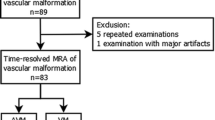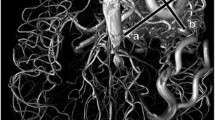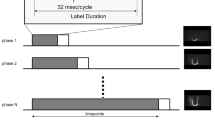Abstract
Objective
HYPR flow is a 3D dynamic contrast-enhanced MRA technique providing isotropic sub-millimetre resolution with half-second temporal resolution. We compared HYPR flow and time-resolved imaging of contrast kinetics (TRICKS) MRA for the characterization of cerebral arteriovenous malformations (cAVMs), using catheter DSA as reference.
Methods
Twenty-two patients underwent HYPR flow and TRICKS MRA within 15 days of DSA. HYPR flow and TRICKS datasets were reviewed separately by two readers for image quality, Spetzler–Martin grade, venous ectasia, and deep venous drainage.
Results
Image quality was better for HYPR flow than for TRICKS (narrower full width at half maximum; larger arterial diagnostic window; greater number of arterial frames, P ≤ 0.05). Using HYPR flow, inter-reader agreement was excellent for all cAVM characteristics. The agreement with DSA for the overall Spetzler–Martin grade was excellent for HYPR flow (ICC = 0.96 and 0.98, depending on the reader) and TRICKS (ICC = 0.82 and 0.95). In comparison to TRICKS, HYPR flow showed higher concordance with DSA for the identification of venous ectasia and deep venous drainage.
Conclusion
Owing to an excellent agreement with DSA with respect to depiction of the vascular architecture of cAVMs, HYPR flow could be useful for the non-invasive characterization of cAVMs.
Key Points
• Dynamic MRA is used for cerebral AVM depiction and follow-up
• HYPR flow is a new, highly-resolved dynamic MRA sequence
• HYPR flow provides whole brain coverage
• HYPR flow provides excellent agreement with the Spetzler–Martin grade
• Compared to TRICKS MRA, HYPR flow improves cerebral AVM characterization



Similar content being viewed by others
Abbreviations
- ADW:
-
Arterial diagnostic window
- cAVM:
-
cerebral arteriovenous malformation
- D-CE-MRA:
-
Dynamic time-resolved contrast-enhanced MRA
- FWHM:
-
Full width at half maximum
- HYPR flow:
-
Highly constrained back-projection with phase contrast as a constraint
- ICC:
-
Intraclass correlation coefficients
- PC:
-
Phase contrast
- SD:
-
Standard deviation
- TRICKS:
-
Time-resolved imaging of contrast kinetics
- VIPR:
-
Vastly undersampled isotropic voxel radial projection imaging
References
Hernesniemi JA, Dashti R, Juvela S, Väärt K, Niemelä M, Laakso A (2008) Natural history of brain arteriovenous malformations: a long-term follow-up study of risk of hemorrhage in 238 patients. Neurosurgery 63:823–829
Ondra SL, Troupp H, George ED, Schwab K (1990) The natural history of symptomatic arteriovenous malformations of the brain: a 24-year follow-up assessment. J Neurosurg 73:387–391
Eddleman CS, Jeong HJ, Hurley MC et al (2009) 4D radial acquisition contrast-enhanced MR angiography and intracranial arteriovenous malformations: quickly approaching digital subtraction angiography. Stroke 40:2749–2753
Spetzler RF, Martin NA (1986) A proposed grading system for arteriovenous malformations. J Neurosurg 65:476–483
Yamada S, Takagi Y, Nozaki K, Kikuta K, Hashimoto N (2007) Risk factors for subsequent hemorrhage in patients with cerebral arteriovenous malformations. J Neurosurg 107:965–972
Stapf C, Mast H, Sciacca RR et al (2006) Predictors of hemorrhage in patients with untreated brain arteriovenous malformation. Neurology 66:1350–1355
Hunt CH, Hartman RP, Hesley GK (2009) Frequency and severity of adverse effects of iodinated and gadolinium contrast materials: retrospective review of 456,930 doses. AJR Am J Roentgenol 193:1124–1127
Thiex R, Norbash AM, Frerichs KU (2010) The safety of dedicated-team catheter-based diagnostic cerebral angiography in the era of advanced noninvasive imaging. AJNR Am J Neuroradiol 31:230–234
Gauvrit J-Y, Oppenheim C, Nataf F et al (2006) Three-dimensional dynamic magnetic resonance angiography for the evaluation of radiosurgically treated cerebral arteriovenous malformations. Eur Radiol 16:583–591
Petkova M, Gauvrit J-Y, Trystram D et al (2009) Three-dimensional dynamic time-resolved contrast-enhanced MRA using parallel imaging and a variable rate k-space sampling strategy in intracranial arteriovenous malformations. J Magn Reson Imaging 29:7–12
Korosec FR, Frayne R, Grist TM, Mistretta CA (1996) Time-resolved contrast-enhanced 3D MR angiography. Magn Reson Med 36:345–351
Reinacher P, Reinges MHT, Simon VA, Hans FJ, Krings T (2007) Dynamic 3-D contrast-enhanced angiography of cerebral tumours and vascular malformations. Eur Radiol 17:52–62
Velikina JV, Johnson KM, Wu Y, Samsonov AA, Turski P, Mistretta CA (2010) PC HYPR flow: a technique for rapid imaging of contrast dynamics. J Magn Reson Imaging 31:447–456
Hadizadeh DR, Kukuk GM, Steck DT et al (2012) Noninvasive evaluation of cerebral arteriovenous malformations by 4D-MRA for preoperative planning and postoperative follow-up in 56 patients: comparison with DSA and intraoperative findings. AJNR Am J Neuroradiol 33:1095–1101
Wu Y, Chang W, Johnson KM et al (2011) Fast whole-brain 4D contrast-enhanced MR angiography with velocity encoding using undersampled radial acquisition and highly constrained projection reconstruction: image-quality assessment in volunteer subjects. AJNR Am J Neuroradiol 32:47–50
Lu A, Brodsky E, Grist TM, Block WF (2005) Rapid fat-suppressed isotropic steady-state free precession imaging using true 3D multiple-half-echo projection reconstruction. Magn Reson Med 53:692–699
Wu Y, Johnson K, Kecskemeti SR et al (2011) Time resolved contrast enhanced intracranial MRA using a single dose delivered as sequential injections and Highly Constrained Projection Reconstruction (HYPR CE). Magn Reson Med 65:956–963
Gu T, Korosec FR, Block WF et al (2005) PC VIPR: a high-speed 3D phase-contrast method for flow quantification and high-resolution angiography. AJNR Am J Neuroradiol 26:743–749
Chang W, Loecher MW, Wu Y et al (2012) Hemodynamic changes in patients with arteriovenous malformations assessed using high-resolution 3D radial phase-contrast magnetic resonance angiography. AJNR Am J Neuroradiol 33:1565–1572
Smith SM, Jenkinson M, Woolrich MW et al (2004) Advances in functional and structural MR image analysis and implementation as FSL. Neuroimage 23:208–219
Chang W, Wu Y, Johnson K, et al Fast contrast-enhanced 4D MRA and 4D flow MRI using constrained reconstruction (HYPRFlow): potential applications for brain arteriovenous malformations. AJNR Am J Neuroradiol. doi:10.3174/ajnr.A4245
Raoult H, Ferre J-C, Morandi X et al (2010) Quality-evaluation scheme for cerebral time-resolved 3D contrast-enhanced MR angiography techniques. AJNR Am J Neuroradiol 31:1480–1487
Kramer H, Michaely HJ, Requardt M et al (2007) Effects of injection rate and dose on image quality in time-resolved magnetic resonance angiography (MRA) by using 1.0M contrast agents. Eur Radiol 17:1394–1402
Miyasaka Y, Yada K, Ohwada T, Kitahara T, Kurata A, Irikura K (1992) An analysis of the venous drainage system as a factor in hemorrhage from arteriovenous malformations. J Neurosurg 76:239–243
Stefani MA, Porter PJ, terBrugge KG, Montanera W, Willinsky RA, Wallace MC (2002) Angioarchitectural factors present in brain arteriovenous malformations associated with hemorrhagic presentation. Stroke 33:920–924
Saleh RS, Lohan DG, Villablanca JP, Duckwiler G, Kee ST, Finn JP (2008) Assessment of craniospinal arteriovenous malformations at 3T with highly temporally and highly spatially resolved contrast-enhanced mr angiography. AJNR Am J Neuroradiol 29:1024–1031
Raoult H, Bannier E, Robert B, Barillot C, Schmitt P, Gauvrit J-Y (2014) Time-resolved spin-labeled MR angiography for the depiction of cerebral arteriovenous malformations: a comparison of techniques. Radiology 271:524–533
Edjlali M, Roca P, Rabrait C et al (2014) MR selective flow-tracking cartography: a postprocessing procedure applied to four-dimensional flow MR imaging for complete characterization of cranial dural arteriovenous fistulas. Radiology 270:261–268
Acknowledgments
We thank the Delegation à la Recherche Clinique of Sainte-Anne Hospital and the URC/CIC of Necker - Cochin Hospital for their help in conducting the study. The results of this work were presented at the ISMRM 21st Annual Meeting, in April 2013. The scientific guarantor of this publication is Pr Catherine Oppenheim. One the authors of this manuscript declares relationships with the following company: Cécile Rabrait was empoyed by GE Healthcare® at the time of the study. This study has received funding by the “Société Française de Radiologie” (French Radiology Society). One of the authors (Olivier Naggara) has significant statistical expertise. No complex statistical methods were necessary for this paper. Institutional review board approval was obtained. Written informed consent was obtained from all subjects (patients) in this study. No study subjects or cohorts have been previously reported. Methodology: prospective, diagnostic or prognostic study, performed at one institution.
Author information
Authors and Affiliations
Corresponding author
Additional information
Raphaël Dautry and Myriam Edjlali contributed equally to this work.
Rights and permissions
About this article
Cite this article
Dautry, R., Edjlali, M., Roca, P. et al. Interest of HYPR flow dynamic MRA for characterization of cerebral arteriovenous malformations: comparison with TRICKS MRA and catheter DSA. Eur Radiol 25, 3230–3237 (2015). https://doi.org/10.1007/s00330-015-3745-9
Received:
Revised:
Accepted:
Published:
Issue Date:
DOI: https://doi.org/10.1007/s00330-015-3745-9




